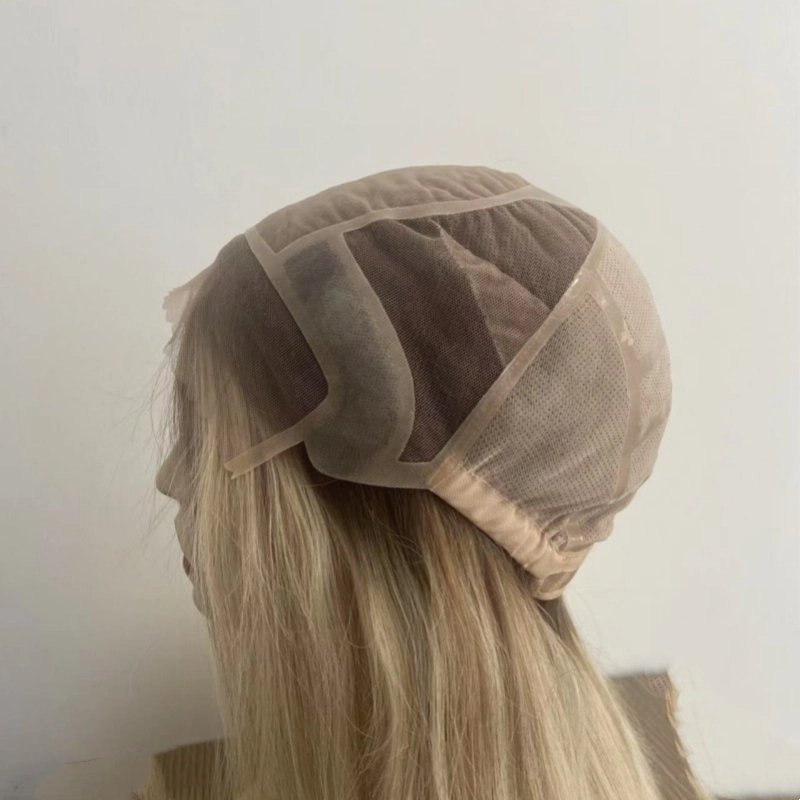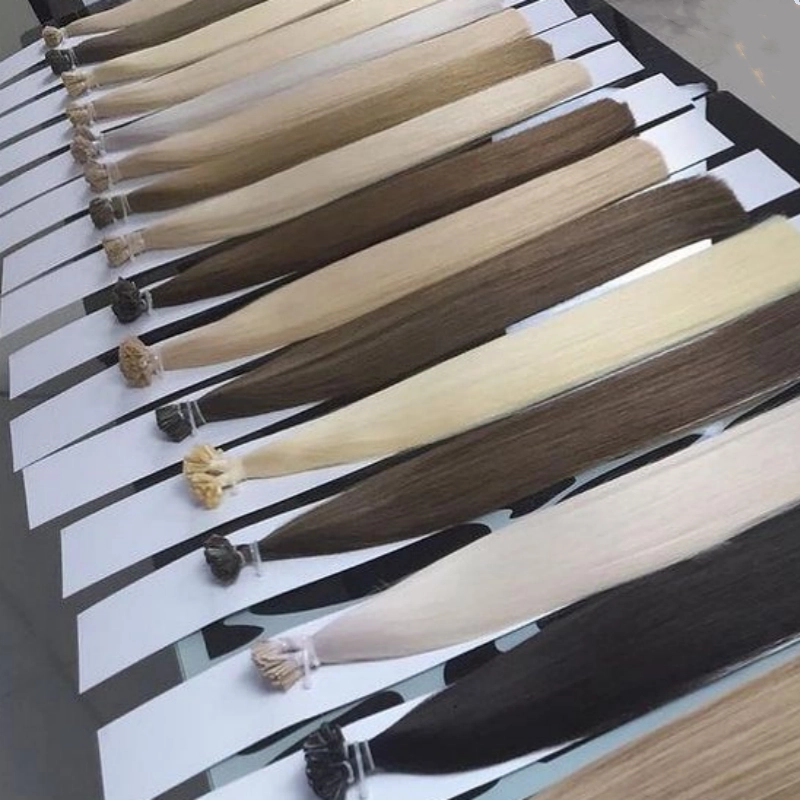A wig is a full headpiece that covers the entire scalp, made from either synthetic fibers or natural human hair. Wigs offer a quick way to transform one’s look or provide a solution for people experiencing hair loss due to medical conditions like alopecia or chemotherapy.

Picture shown wearing a wig can instantly add volume, help manage hair loss, and allow for a complete style transformation.
Full wigs cover the entire head, offering complete coverage for those who need a new style or those with hair loss. Full wigs come in various lengths, textures, and colors. They are ideal for people seeking a completely new look without the commitment of permanent hair changes.
These wigs feature a lace panel along the hairline, creating a natural-looking, undetectable hairline. The rest of the wig may be made from different materials, offering a more affordable price point while providing the appearance of a natural hairline. Lace front wigs are often lighter than full wigs, making them more breathable.
Full lace wigs are constructed entirely from lace material, which allows for more flexibility, including wearing the wig in different styles like updos or ponytails. These wigs provide the most natural appearance and are often worn by those looking for a premium option.
360 lace wigs feature lace around the perimeter of the head, offering a full range of styling options like ponytails or braids while maintaining a seamless appearance. These wigs can be more expensive due to their versatility.
These are specifically designed for individuals experiencing hair loss due to medical conditions. Medical wigs are often lighter, more comfortable, and have a more natural look, as they are made to mimic natural hair growth patterns. These wigs are often available in custom sizes for comfort.

Picture shown A lace front silk top silicone medical wig combines a realistic lace front, a soft silk top for a natural scalp appearance, and silicone for a secure, glue-free fit, making it an ideal choice for individuals experiencing hair loss due to medical conditions.
To wear a wig, you’ll need to first prepare your natural hair by pinning it down or securing it under a wig cap. The wig cap helps keep your natural hair in place and provides a smooth surface for the wig to rest. Many wigs come with adjustable straps, hooks, or clips to ensure a snug and secure fit.
Pin your natural hair flat, or use a wig cap to secure it. This helps prevent bulk under the wig, allowing it to fit properly.
Hold the wig from the front and gently slide it over your head, adjusting the fit as needed. Some wigs have ear tabs to help position them correctly.
If your wig has clips or adjustable straps, secure them to ensure the wig stays in place.
Once the wig is secured, you can style it using your fingers or a wig brush.
Wigs require different levels of maintenance depending on the material and type:
Synthetic wigs are easy to care for and don’t require much maintenance. They are pre-styled, so you don’t have to worry about curling or straightening. However, they are not heat-resistant, and excessive heat can damage the fibers. It’s best to wash them every 7-10 wears, using a wig-friendly shampoo and conditioner. After washing, allow the wig to air dry.
Human hair wigs are the most versatile and require similar care to natural hair. You can wash, style, curl, or straighten them. Regular washing (every 10-14 wears) is recommended, and you should use high-quality hair care products. To preserve the wig’s texture and longevity, keep it conditioned and use heat protectant products when styling.
Wigs come in a wide range of prices based on factors such as the material used (synthetic vs. human hair), the brand, the quality of craftsmanship, and the length or style of the wig. Below is a more detailed breakdown of the pricing range for both synthetic and human hair wigs.
Price Range: $30 – $200
Synthetic wigs are typically the most affordable wig option, often chosen by individuals looking for a temporary or budget-friendly solution. They are made from synthetic fibers that are designed to mimic the look and feel of natural hair. However, they may not be as durable or versatile as human hair wigs.
Price Range: $150 – $3,000+
Human hair wigs are the most premium option available, offering the most natural appearance and styling versatility. Made from 100% human hair, these wigs can be styled, washed, and treated just like natural hair, providing a long-lasting solution.
Wigs with complex cap constructions, such as lace fronts, full lace, or silk bases, are generally more expensive due to their natural appearance, breathability, and comfort.
For example, a lace front wig may cost between $100 – $600, while a full lace wig may range from $300 – $2,000.
The longer the hair, the more expensive the wig is likely to be. Wigs made from longer hair (e.g., 22–30 inches) can cost significantly more than those with shorter lengths (e.g., 12–14 inches).
European hair: European hair is more expensive because it is rarer and softer, often coming from countries like Russia, Ukraine, and parts of Western Europe. These wigs can be priced from $1,500 to over $3,000.
Indian and Chinese hair: While still of high quality, wigs made from Indian or Chinese hair are typically more affordable, ranging from $150 to $1,500.
Customized wigs with specific features (e.g., custom color, texture, or length) can drive up the price. Custom wigs often require longer production times and specialized techniques, which increase the cost.
| Type of Wig | Price Range | Description |
| Synthetic Wigs | $30 – $200 | Affordable, pre-styled, limited styling options, not heat-resistant. |
| Lower-End Human Hair Wigs | $150 – $500 | Budget-friendly, less durable, and may be chemically processed. |
| Mid-Range Human Hair Wigs | $500 – $1,500 | Higher quality, Remy hair, longer-lasting, and versatile. |
| High-End Human Hair Wigs | $1,500 – $3,000+ | Premium European or Virgin Remy hair, natural look, highly durable. |
Wig pricing is influenced by several factors, including material (synthetic vs. human hair), quality, cap construction, length, and customization. While synthetic wigs offer a more affordable and lower-maintenance option, human hair wigs provide a more natural look, versatility, and durability at a higher price point. By understanding the different pricing ranges and options, you can select the wig that best meets your needs and budget, whether you’re looking for a temporary solution or a long-term investment.

Picture shown that Adding hair extensions can dramatically enhance length and volume, transforming your hairstyle from thin and short to full and flowing in an instant.
Hair extensions are individual pieces of hair that are added to natural hair to increase volume, length, or thickness. Extensions come in a wide variety of forms, from clip-ins that offer temporary results to more permanent options like sew-ins or keratin bonds.
Clip-in extensions are the most temporary and easiest-to-use type of hair extension. They come in wefts or individual pieces that can be clipped to natural hair. They are ideal for individuals who want to add volume or length for a special occasion or night out.
Tape-in extensions involve attaching strips of hair using medical-grade adhesive tape. These extensions lie flat against the scalp and provide a natural, seamless look. They are semi-permanent and can last 6-8 weeks before needing to be replaced or repositioned.
Sew-in extensions are attached by braiding natural hair into cornrows and then sewing the extensions onto the braids. These extensions last several weeks to a few months and require a professional to install and remove. They are ideal for people with thick or coarse hair.
These extensions are applied using a heat tool to bond keratin beads to your natural hair. I-tip and U-tip extensions require a professional application and can last up to 6 months with proper care. They are ideal for long-term wear.

Picture shown Pre-bonded flat tip hair extensions are applied using a heat-based fusion method, where each extension is securely bonded to natural hair with a flat, discreet tip, providing a long-lasting, seamless look with added volume and length.
Halo extensions are a non-permanent, easy-to-use method. A thin, flexible wire is placed over the head, and the hair extensions hang from the wire. This method requires no clips or glue and is perfect for someone seeking a quick transformation.
Part your hair in sections, then clip the extensions into your natural hair, ensuring that they are securely in place. The more sections you create, the more volume you can add.
Your stylist will apply tape-in extensions to your hair in thin sections, sandwiching your natural hair between two pieces of extension hair.
A stylist will braid your hair in small sections, creating cornrows to which the extensions are sewn. This method requires professional help.
A stylist will bond the extensions to your natural hair using a heated keratin tool. The extensions are attached near the root of your natural hair.
Place the halo wire over your head and adjust the extensions so they hang naturally around your natural hair. This method is simple and requires no professional assistance.
Clip-in Extensions: Since these are temporary, they require minimal care. Wash them after a few wears and store them in a safe place to prevent tangling.
Tape-in extensions need to be repositioned every 6-8 weeks as your natural hair grows. You must also avoid using products with oil or alcohol near the tape, as they can loosen the adhesive.
These extensions require maintenance every 6-8 weeks, including re-tightening and adjustments to the braids. Washing and conditioning the hair regularly is also important.
These extensions need to be maintained every 6-8 weeks. Regular hair washing and using sulfate-free products are important to prolong the life of the extensions.
Since they are temporary, they require minimal care, but it’s best to remove them before sleeping to prevent tangling.
The cost of hair extensions depends on the method, material, and length. Here’s an overview of typical prices:
When deciding between wigs and hair extensions, it’s important to understand the key differences, advantages, and considerations for each option. Both offer the ability to change or enhance your hairstyle, but they do so in different ways. Here’s a deeper dive into how wigs and hair extensions compare, to help you make an informed decision.
Wigs cover the entire head, making them ideal for individuals who want to completely change their look or those dealing with hair loss due to medical conditions. They offer full coverage and can drastically alter one’s appearance in a matter of minutes. Wigs are especially beneficial for individuals undergoing chemotherapy or experiencing alopecia.
Hair extensions, on the other hand, are designed to add length, volume, and thickness to your natural hair without covering the scalp. Extensions can be clipped in, taped, sewn, or bonded to your natural hair, giving a more subtle change compared to wigs. They enhance your natural hair and add fullness or length, but they don’t cover the scalp entirely.
Wigs are relatively easy to put on. For most wigs, especially full wigs or lace fronts, you simply need to secure them onto your head, either by adjusting the straps, clips, or hooks that come with the wig. The application process can take just a few minutes, making wigs a more convenient option for quick style changes.
The installation process for hair extensions varies depending on the method you choose. Clip-in extensions are easy to apply and can be done at home, while tape-in, sew-in, or keratin bond extensions require professional application. Installation times can range from 30 minutes to 2 hours, depending on the method used.
Wigs generally last between 6 months to 1 year, depending on how often they are worn, how well they are maintained, and whether they are made from synthetic or human hair. Synthetic wigs tend to have a shorter lifespan due to wear and tear, while human hair wigs can last much longer if properly cared for.
Durability: Synthetic wigs last 3-6 months, human hair wigs last 1-2 years or more.
Maintenance: Regular cleaning and proper storage are essential to prolong the lifespan of the wig.
Hair extensions, especially those made from human hair, can last anywhere from 6 months to 1 year or more, depending on the type and how well they are maintained. Clip-in extensions tend to last the longest, while tape-in and keratin-bonded extensions may need reapplication every 6-8 weeks as your natural hair grows out.
Durability: Can last 6 months to 1 year, but need frequent adjustments (for tape-ins, sew-ins, etc.).
Maintenance: Regular care is required to avoid tangling, shedding, or breakage.
Wigs made from human hair offer a high level of styling versatility. They can be straightened, curled, or even dyed, just like natural hair. However, synthetic wigs are pre-styled and typically cannot be restyled with heat, limiting your options. While some high-end synthetic wigs are heat-resistant, they still don’t provide the same styling flexibility as human hair wigs.
Hair extensions, particularly those made from human hair, offer excellent styling options. You can curl, straighten, and style them just like your natural hair. Even synthetic extensions (to a limited degree) can be styled with heat, although they may not hold the style as well as human hair extensions.
Wigs can sometimes feel heavy or uncomfortable, especially if they are made with thick materials or lack proper ventilation. Lace front wigs are often more breathable and lighter, but full wigs with dense wefts can trap heat, leading to discomfort, particularly in warm climates.
Breathability: Lace front and full lace wigs offer better ventilation; full wigs may be less breathable.
Hair extensions are generally more comfortable than wigs because they are attached to natural hair and feel lighter. However, they may require regular upkeep (e.g., tape-in extensions need to be repositioned, or sew-in extensions may feel heavy after several weeks). Most extensions, once installed, are relatively comfortable and breathable.
Wigs are generally more expensive upfront compared to hair extensions, especially high-quality human hair wigs. The initial cost can range from $30 for basic synthetic wigs to over $3,000 for premium human hair wigs. While wigs can be a long-term investment, they typically don’t require as frequent maintenance as hair extensions.
Hair extensions, especially high-quality human hair extensions, can also be expensive, with prices ranging from $30 for clip-ins to over $1,500 for professional installations like keratin bonds or sew-ins. While they don’t require as much initial investment as wigs, they need to be maintained and reapplied, which can add to the cost over time.
Wigs are a go-to option for people who need a quick, dramatic change in their look. They offer more versatility in terms of drastic style changes (e.g., going from short to long hair or changing hair color entirely). However, they require more time and effort to style and maintain if worn regularly.
Extensions are great for enhancing your natural hair without a drastic change. They offer versatility for adding volume, length, or color in a way that appears more subtle than wigs. However, they cannot completely transform your look like a full wig can.
| Feature | Wigs | Hair Extensions |
| Coverage | Full head coverage | Adds length, volume, or thickness |
| Application Time | 5-10 minutes | 30 minutes to 2 hours (depends on method) |
| Durability | 6 months to 2 years (depending on material) | 6 months to 1 year (depending on type) |
| Styling Flexibility | High for human hair wigs, limited for synthetic wigs | High for human hair extensions, moderate for synthetic |
| Comfort | Can be uncomfortable (depending on construction) | Generally more comfortable |
| Cost | $30 – $3,000+ | $30 – $1,500+ |
| Versatility | High for full transformations | Moderate for enhancements |
| Maintenance | Moderate to high, depending on material | High, depending on the type and application meth |
The decision to wear a wig or use hair extensions largely depends on your needs, lifestyle, and budget.

Picture shown that EMEDA flat tip hair extensions come in a wide range of vibrant colors, from natural shades to bold highlights, allowing you to effortlessly match or transform your look with a flawless, customized color blend.
EMEDA Hair Factory is renowned for its high-quality wigs, hairpieces, and extensions, using only the finest human hair sourced ethically. Whether you’re looking for custom hairpieces, premium wigs, or versatile extensions, EMEDA ensures that every product meets strict quality standards, providing a natural look, smooth texture, and long-lasting durability.
EMEDA offers a wide range of customization options, allowing customers to personalize their wigs, hairpieces, and extensions to their exact specifications. From hair texture and color to base material and cap construction, you can get a product that perfectly matches your unique needs and preferences, whether for individual or wholesale orders.
With a large inventory of ready-to-ship products, EMEDA ensures fast and efficient delivery for both individual customers and businesses. Whether you’re a salon, wholesaler, or a consumer, EMEDA’s quick processing and shipping times make it easy to get the products you need without delays.
EMEDA offers premium-quality hair products at competitive prices, making it accessible for a wide range of customers. Thanks to their direct manufacturing capabilities, EMEDA can provide high-quality hairpieces and extensions at a fraction of the price you might find elsewhere, without compromising on quality or style.
At EMEDA, sustainability is a top priority. The company invests in eco-friendly manufacturing processes, ensuring that their products not only meet aesthetic and functional needs but also contribute to a more sustainable beauty industry. EMEDA strives to innovate with new technologies and products while maintaining ethical sourcing and reducing their environmental footprint.
By choosing EMEDA Hair Factory, you gain access to premium products, customization, and fast delivery, all while supporting a company that values quality, sustainability, and innovation.
Both wigs and hair extensions from EMEDA Hair offer incredible benefits for those looking to enhance their appearance. Whether you opt for a wig for full coverage or hair extensions for added volume and length, EMEDA provides high-quality options that are customizable to suit your needs. With a wide range of materials, colors, and styles, you can find the perfect product to match your preferences. EMEDA’s commitment to fast shipping, sustainable practices, and competitive pricing ensures that you get premium hair solutions at an affordable cost, no matter your budget. Whether you’re an individual, salon, or wholesaler, EMEDA Hair offers versatility, quality, and convenience for all your hair enhancement needs.
Dont hesitate to Contact EMEDA Hair Factory:
👉WhatsApp: +8618562611500
👉Email: sales11@emedahair.com

New customization and stock clearance
WhatsApp us